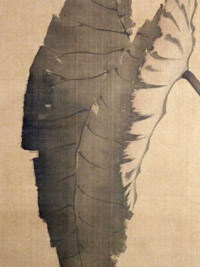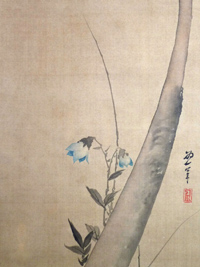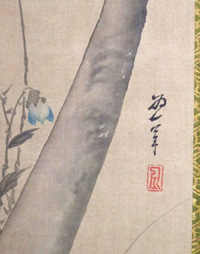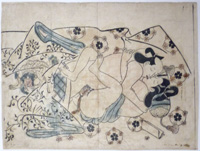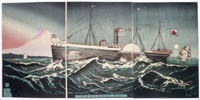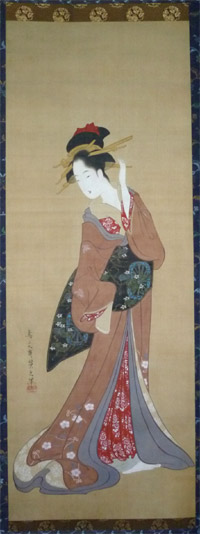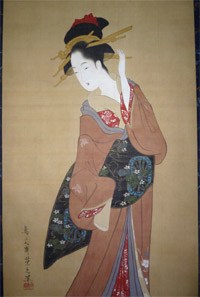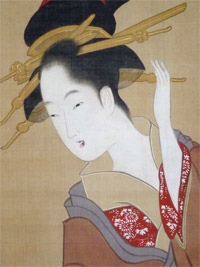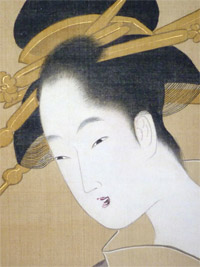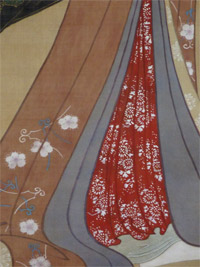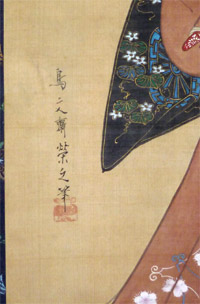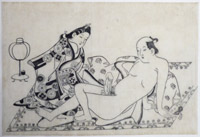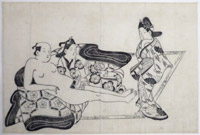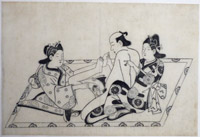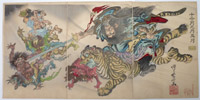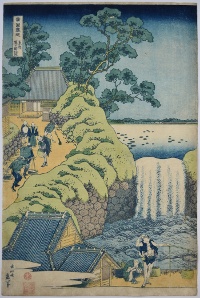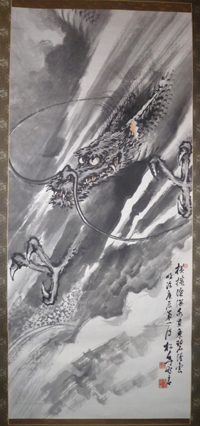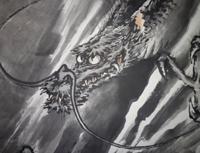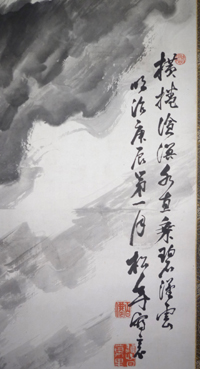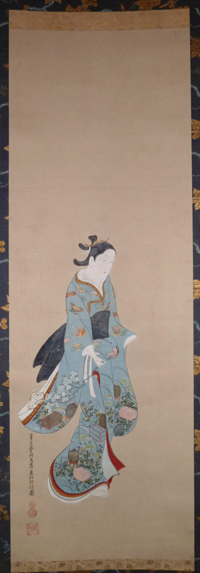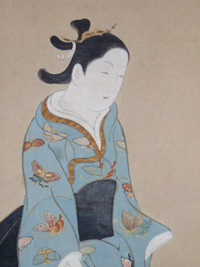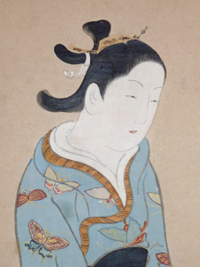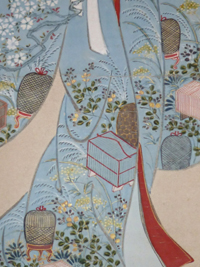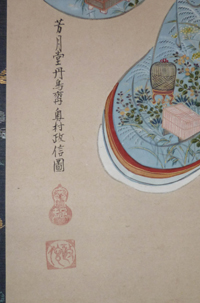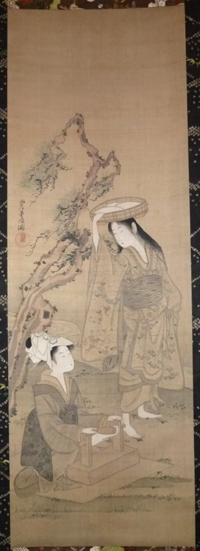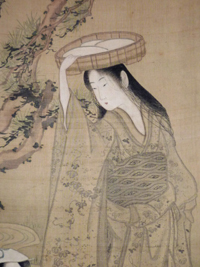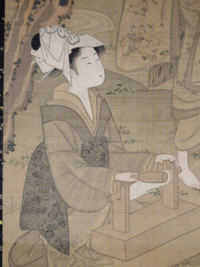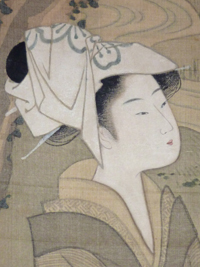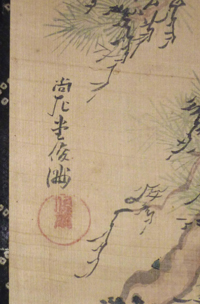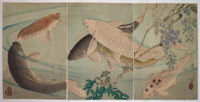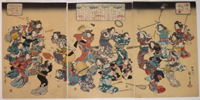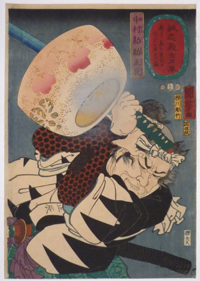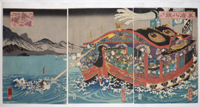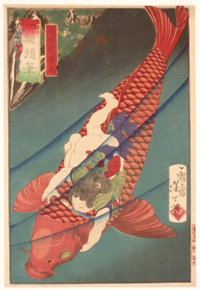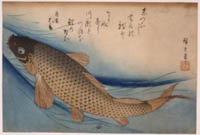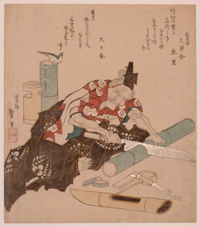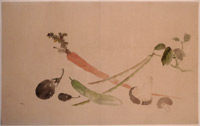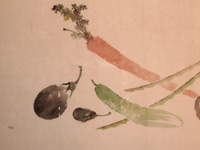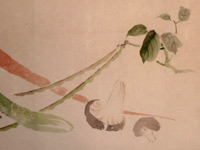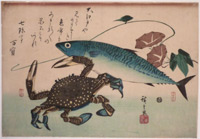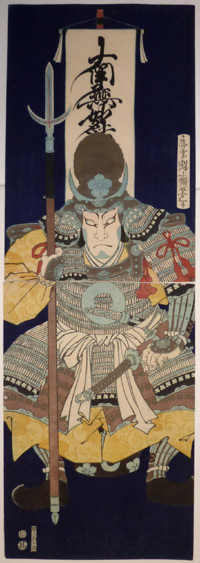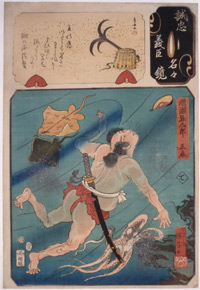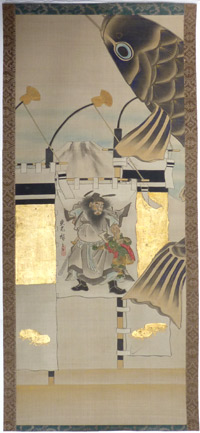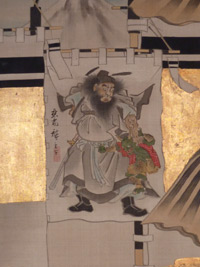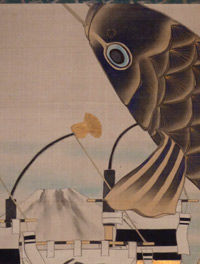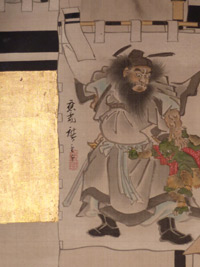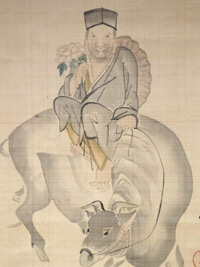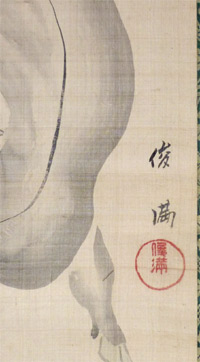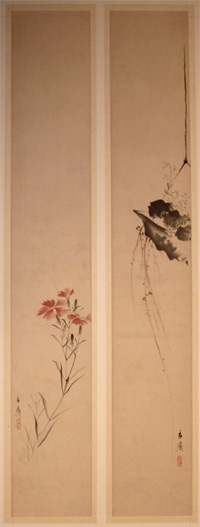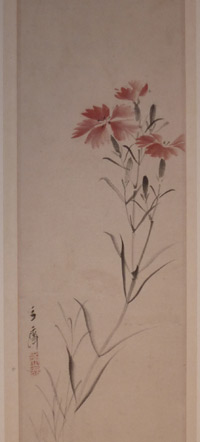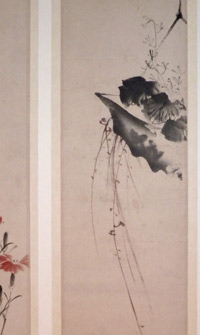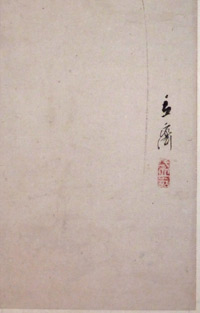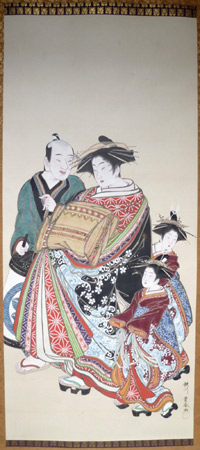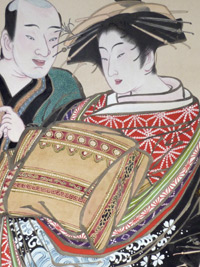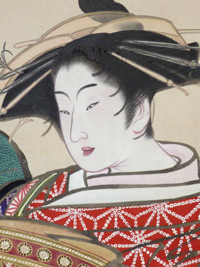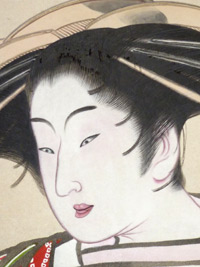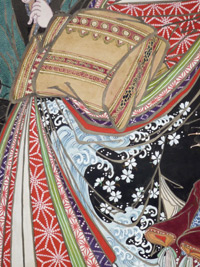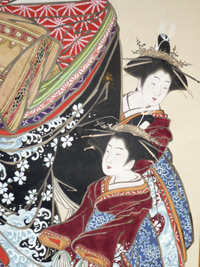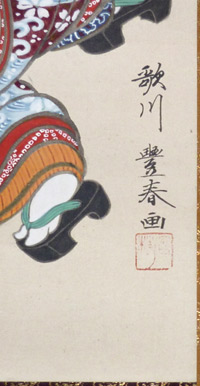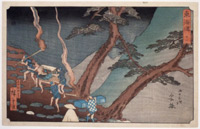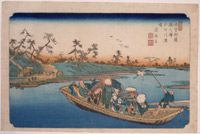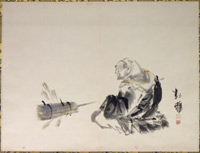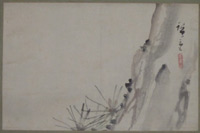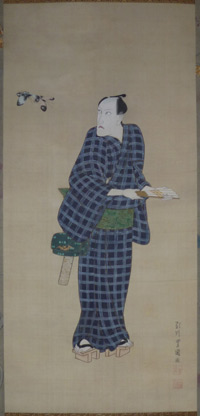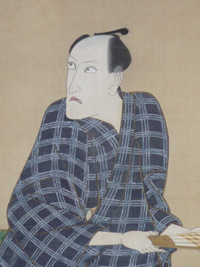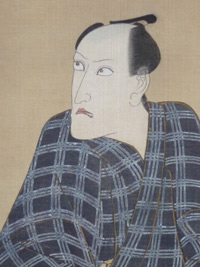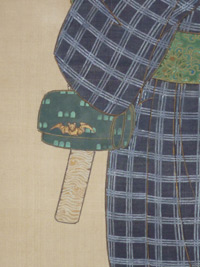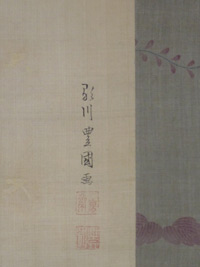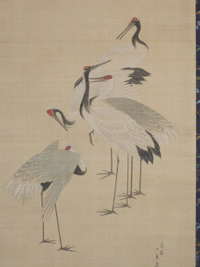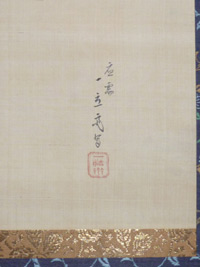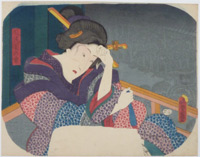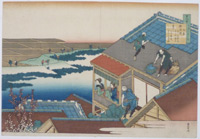/category/archive/page/31/
Katsushika HOKUSAI (1760-1849)
Click here to view image full size.
An important original painting showing a taro plant and balloon flowers. This statuesque plant is known as the village potato in Japan ( satoimo ) for its edible corms and “elephant ears” when grown ornamentally. Above is a poem by Ota Shokusanjin ( Ota Nampo ), a famous late Edo period poet and writer. The poem reads:
Aki chikoo saitsuru hanano koikaze ni
Kaburiwo fureru imoha arashina
Shokusanjin
Interestingly, Shokusanjin’s calligraphy is often at a slant. Why this should be I cannot say. The taro appears in other Hokusai paintings and there is another close version of this painting illustrated in the Special Exhibition, Hokusai, Nagoya City Museum, 1991.10.26 – 1991.11.24, no. 210. Hokusai often duplicated subjects as he was near to destitution many times. The painting employs the tarashi- komi – Rimpa technique of colours dripped or brushed into wet ink. Sumi and light colour on silk, 42.5 in; 108 cms x 11 in; 28 cms. Newly remounted and in fine condition with new box and futo-maki ( thick wooden roll to preserve the painting from damage ). Signed Iitsu hitsu with seal Iitsu. Sold together with what is probably the original box.
Status: Sold
Sugimura JIHEI (Fl. c. 1680-1698)
Click here to view image full size.
The most prolific of Moronobu’s pupils and was originally confused with him, but now properly identified as a separate artist. Produced some of the finest erotic designs. A couple in flagrante beneath a sumptuous duvet. Published c. mid 1680’s.
A large oban ( 11in; 27cms x 14.5in; 36.75cms ).
Good impression. Some restorations but generally good condition. Partially hand-coloured. Unsigned ( as usual ).
Status: Sold
Kobayashi KIYOCHIKA (1847-1915)
Click here to view image full size.
An extremely rare triptych: Sunshu Moho kokai chu no Fuji. Shows the paddle-steamer Daikokuya ploughing through the Sea of Miho, Suruga Province. The first rays of the sun hit the top of Mount Fuji. Kiyochika was an interesting artist: Although mainly self-taught, he also studied photography in Yokohama with Shimaoka Renjo and then the rudiments of western-style oil painting with the English correspondent, cartoonist, and painter Charles Wirgman. The influence of imported lithographs and etchings is evident in this print. Published by Matsuki Heikichi, 1878.
Very fine impression of the first edition with strong variegation in the sky, top left. Fine colour. Very slight trimming, otherwise very good condition. Signed Kobayashi Kiyochika hitsu.
Status: Sold
Hosoda EISHI (1756-1829)
Click here to view image full size.
A fine original painting by one of the best known Ukiyo-e artists. This high ranking individual produced some of the most refined prints during the late 1780s and the 1790s. He had many pupils including Eisho, Eiri and Eisui. Shows a standing beauty painted c. late 1790s. One hand adjusts a hairpin, while the other holds a partly concealed letter. Image size 35.25 x 13 in; 89.5 x 33 cms. Exquisitely painted in full colour on silk. In very good condition with futo-maki ( thick wooden roll to preserve the painting from damage ) and fine new mount and box. Signed Chobunsai Eishi hitsu with Eishi seal.
Status: Sold
Hishikawa MOROSHIGE (active c. 1684-1695)
Click here to view image full size.
A shunga print by the best of Moronobu’s direct pupils, who produced some of the finest designs in this genre. Shows a couple prior to coitus. Published c. mid 1680s.
Very good impression. Very slight soil and weakening along laid lines, but otherwise very good condition. Unsigned.
Status: Sold
Hishikawa MOROSHIGE (active c. 1684-1695)
Click here to view image full size.
A shunga print by the best of Moronobu’s direct pupils, who produced some of the finest designs in this genre. Shows a couple prior to coitus being approached by an attendant. Published c. mid 1680s.
Very good impression. Very slight soil and weakening along laid lines, but otherwise very good condition. Unsigned.
Status: Sold
Hishikawa MOROSHIGE (active c. 1684-1695)
Click here to view image full size.
A shunga print by the best of Moronobu’s direct pupils, who produced some of the finest designs in this genre. Shows a couple in flagrante aided by an attendant. Published c. mid 1680s.
Very good impression. Very slight soil and weakening along laid lines, but otherwise very good condition. Unsigned.
Status: Sold
Hishikawa MOROSHIGE (active c. 1684-1695)
Click here to view image full size.
A shunga print by the best of Moronobu’s direct pupils, who produced some of the finest designs in this genre. Shows a couple in flagrante, the huge duvet slipping off their bodies. Published c. mid 1680s.
Very good impression. Very slight soil and weakening along laid lines, but otherwise very good condition. Unsigned.
Status: Sold
Kawanabe KYOSAI (1831-1889)
Click here to view image full size.
MAY in romaji from a set of the twelve months, Junikagetsu no uchi, although this is the only known design for the set. One of Kyosai’s best designs. Shows Shoki, the “Demon Queller” riding a tiger and brandishing his two-edged sword at a group of terrified oni. Shoki ( Chinese: Chung K’wei ) was lauded for having relieved the Emperor Ming Hwang of the fever demon during his sleep. A favourite subject for Japanese artists, although mostly ignored by the Chinese. Published by Fukuda Kumajiro, 1887. Paintings of Shoki were hung on Boy’s Day ( 5th day of the 5th month ). Hence Kyosai choosing this subject for May.
Fine impression and colour. Very slight edge foxing, otherwise fine condition. This design is notorious for often being heavily trimmed and consequently for the three sheets not aligning properly. This example completely untrimmed with extra paper all round. Rare. Signed Kyosai ga.
Status: Sold
Taiso YOSHITOSHI (1839-1892)
Click here to view image full size.
Soga no Goro galloping at high speed, whipping the steed with a bamboo branch. He races to the aid of his brother in Oiso. This famous story tells how the brothers avenged the death of their father Sukeyasu by Suketsune who was under the protection of the shogun Yoritomo. The Soga brothers kill Suketsune but Juro is killed in the ensuing fight and Goro is subsequently beheaded. Published 1885 by Fukuda Yasushi. One of the great Yoshitoshi designs and rare.
Fine impression and colour. In exceptional condition. A design invariably trimmed whilst this impression has all margins intact. Signed Oju Yoshitoshi hitsu.
Status: Sold
Katsushika HOKUSAI (1760-1849)
Click here to view image full size.
The Aoigaoka [waterfall] in Edo: Toto Aoigaoka no taki from a set of eight prints with title, Shokoku taki meguri, “A Journey to the Waterfalls of All the Provinces.” A majestic set with a mostly beautiful unifying colour scheme: There is probably no other Hokusai set that has the same impact when viewed complete. Amongst Hokusai’s finest work and much sought after. There are numerous Hiroshige designs based on the same location but they are prosaic in comparison. Eisen, inspired by Hokusai, also produced a set of waterfalls in 1847 which are themselves fine and rare. This particular fall is in fact a spillway for the Tameike reservoir seen above. Aoi Hill near Toranomon Gate to the left. The set published by Eijudo, c. 1832. Rare.
Fine impression. Fine, unfaded colour. Minimal soil and slight trimming on left: These designs are martyrs to trimming and many illustrated examples are trimmed, otherwise very good condition. (This raises an interesting problem because most Hokusai landscapes do not have a black border – contrary to Hiroshige’s – which do, making it easy to judge the trimming on the latter.) Signed Zen Hokusai Iitsu hitsu.
Status: Sold
Suzuki SHONEN (1849-1918)
Click here to view image full size.
A large painting for the year of the Dragon 1880 ( Meiji 13 ). Suzuki Shonen was a major Kyoto-based Nihonga artist of the late Meiji period. The son of Suzuki Hyakunen, the founder of the Suzuki school of painting, whom he succeeded. He seems to have been a somewhat flamboyant character and was known as the “modern Soga Shohaku.” Shows the Dragon of the Storm descending above turbulent water. A mythological creature that dominated Chinese and Japanese art. It was a scaly four-legged serpent with dorsal spines, the head having two horns, long feelers, and flame-like streamers at the shoulders and hind quarters. Painted in sumi with light touches of red on paper. Image size 56 x 25 in; 143 x 64 cms. Newly mounted. Very good condition. Signed Suzuki Shonen with date seal.
Status: Sold
Okumura MASANOBU (1686-1764)
Click here to view image full size.
A newly discovered painting by one of the most influential artist in Ukiyo-e. His long life covered hand-coloured prints through to full colour printing in the mid 1760s and he was one of the first to use the block-printing process after 1740 and pioneer the benizuri-e picture. Extremely innovative: he pioneered the uki-e print, pillar prints and ishizuri-e. Not only was he a print artist, he also illustrated books, albums and produced paintings. He started his own publishing house, Okumuraya, which gave him greater control over the printing process. The popularity of his work led to many copies by other publishers, and he had to certify his work as “genuine.” Shows a standing beauty, Tachi bijin-zu. She carries a cherry branch and her gorgeous costume is decorated with grasses and flowers with cages for collecting insects and above various colourful butterflies. Full colour on paper, image size 35.75 x 12.25 in; 91 x 31 cms. Fine new mount with futo-maki ( thick wooden roll to preserve the painting from damage ) and box. Fine condition. Ex collection Raizou Kanda. Signed Hogetsudo Tanchosai Okumura Masanobu with seals Masanobu and Okumura. Although long lived, genuine paintings by him are rare.
Status: Sold
Kubo SHUMMAN (1757-1820)
Click here to view image full size.
A fine painting showing a seated girl fulling cloth ( a process of beating which eliminated the dirt and other impurities ) with another standing beauty holding beaten cloth in a wooden tray on her head. This scene represents Mishima, or Toi, Province of Settsu. One of the Six Crystal ( Tama ) Rivers. ( Toi is the alternative name of the river and the word for beating cloth. ) This was probably Shumman’s most celebrated subject. He produced a set of six prints on this theme published by Fushimiya Zenroku, c 1787. One of the most beautiful 18th century sets, and together with a night triptych showing people returning from a poetry reading, is considered his masterpiece. The prints and the known paintings of this subject use the benigirai style, “red avoiding” pioneered by Shumman, Eishi and Shuncho. Shumman, a man of great sophistication, designed only a few prints before concentrating on surimono and printing and issuing some of the finest in this format. ( See The Japanese Print A New Approach, J. Hillier, pp. 102-104: “Probably no artist except Choki has achieved so high a reputation on such a small number of prints.” ) He also excelled at painting, book illustration and light verse. Painted on silk in tones of sumi, very light green, gofun and a small touch of red on the girls’ lips. Image size: 36 x 12 in; 91.5 x 30.5 cms. Other versions of this subject are in the BM ( 1922.2-13.01 ) and the Freer Gallery of Art ( FI903.62 ), gift of Charles Freer. Painted c early 1790s. Slight loss of gofun and very minor spotting, but otherwise in very good condition. Interesting old mount. Exhibited in 1995 at Shunsen Museum in Nanamashi prefecture, Nikushitsu ukiyoe meisaku ten, hosted by Mr Keizaburou Yamaguchi, p. 40, no, 37. Painting guaranteed by Mr Narazaki, the box being signed and dated 1988 by him. Signed Shosado Shumman, with circular Shumman seal.
Status: Sold
Tsukioka YOSHITOSHI (1839-1892)
Click here to view image full size.
A triptych showing koi, “carp” swimming beneath hanging wisteria. One of Yoshitoshi’s finest and most popular designs. Published by Akiyama Buemon, 5/1889. See Beauty and Violence, Society for Japanese Arts, 1992, no. 66, p. 144 for another impression plus the original drawing by Yoshitoshi ( from the British Museum ). Also see this website in Brush Drawings and Hanshita-e for another two original drawings of koi by Yoshitoshi, possibly preliminary working ideas for the British Museum drawing. Yoshitoshi only produced one other carp print, a large surimono. Common carp were first bred for colour in Japan in the 1820s. Their name is a homophone for another word meaning “love” or “fidelity” and they are symbols of love and friendship in Japan.
Very fine impression and colour. Slight oxidation although not as much as is usually found on this design. Slight signs of mounting au verso, otherwise very good condition.
Status: Sold
Utagawa KUNIYOSHI (1797-1861)
Click here to view image full size.
The ronin Nakamura Kansuke Masatatsu dodging a brazier of hot ash. The best design from a fine set of twelve half length portraits of the forty-seven ronin: Seicho gishi shozo, “Portraits of Faithful Samurai of True Loyalty.” The depictions borrow strongly from western portraiture including imitation western script in the green border of the title cartouche. It is not necessary to repeat the story here as it is the best known Japanese tale. Published by Sumiyoshiya Masagoro, 12/1852.
Fine impression, colour and condition. Full size and the falling ash from the brazier represented by sprayed gofun ( slight loss ). The printing on this set is exceptional with details such as the sword blades and title cartouches burnished. Signed Kuniyoshi ga.
Status: Sold
Tsukioka YOSHITOSHI (1839-1892)
Click here to view image full size.
The ghost of Genta Yoshihira, having been executed by Taira no Kiyomori, springs into the air causing a thunderstorm and exacting revenge. The best design from Shingata sanjurokkaisen, “New Forms of Thirty-six Ghosts.” Published 1889 by Sasaki.
Very fine impression, colour and condition. The first edition. Signed Yoshitoshi.
Status: Sold
Utagawa KUNIYOSHI (1797-1861)
Click here to view image full size.
A triptych showing Koman, the widowed daughter of a Lake Biwa farmer, swimming with the white banner of the Genji in her teeth towards the Taira barge of Munemori. On being picked up and finding where she was she jumped overboard but not before Sanemori cut her arm off with the banner wrapped round it. For the full story see Pointers And Clues To The Subjects Of Chinese And Japanese Art, Sampson Low Marstone & Co. Ltd., Will Edmunds, 1934, p. 451. Published By Iseya Ichibei, 1846.
Very fine impression, colour and condition. Full size. Signed Ichiyusai Kuniyoshi ga.
Status: Sold
Utagawa KUNIYOSHI (1797-1861)
Click here to view image full size.
A triptych showing Raiko attacking the Shuten-doji. A well know myth covered by numerous artists of all periods. Shuten-doji, “Great Drunken Boy” had great strength and atrocious habits, plundering the countryside around his stronghold on Oyeyama, “Devil’s Mountain.” The Emperor Murakami, losing patience, ordered Raiko to put an end to his exploits with the aid of a magic cap and poisoned sake. Raiko and his main retainers: Sakata no Kintoki, Usui no Sadamitsu, Watanabe no Tsuna, and Urabe no Suyetake stupefied the enormous hulk that was Shuten-doji and decapitated him. Depictions of this scene usually show the head flying through the air and it often has a more gruesome appearance with fangs and horns. Raiko returned in triumph with the head to Kyoto. One of Kuniyoshi’s best designs. Published c 1851-2 by Amatsu. Robinson T261. Rare.
Fine impression and colour. Some oxidation as usual. Slight trimmimg, otherwise very good condition. Signed Ichiyusai Kuniyoshi ga.
Status: Sold
Tsukioka YOSHITOSHI (1839-1892)
Click here to view image full size.
Saito Oniwakamaru, “Young Devil Child” ( Benkei ) fighting the giant carp in the waterfall of Bishamon ga taki. The best design from a fine set: Ikkai zuihitsu, “Essays by Yoshitoshi.” A set of 13 prints published by Masadaya in 1872. There are numerous variations in seals in this fine set but, as yet, no research has been done into their significance. However, this appears to be the first edition. There are versions with publisher’s seals right margin in red and in black and missing altogether. The earliest impressions, as here, have no gradation below the top two currents. Also, the slightly later editions use stronger aniline colours. One of Yoshitoshi’s great designs.
Fine impression with strong woodgrain. Fine colour. Retains original album backing. Slight trimming top margin. Signed Ikkaisai Yoshitoshi hitsu.
Status: Sold
Ichiryusai HIROSHIGE (1797-1858)
Click here to view image full size.
Koi, carp ( Cyprinus carpio ), swimming amongst reeds. Poem by Makuzu. From the second series of ten fish prints published by Yamasho, c 1840-42. The first series was issued privately for a poetry group ( probably the Shingyoku Cicle ) with judges’ names and extra poems. These prints are of the utmost rarity as probably only enough for the Cirle were made and they never come onto the market. Due to their popularity this second set was commissioned.This is the very rare first edition with the reeds printed. Block defect showing but with gradation still on belly. One of the finest designs from the two series. Very rare. Kruml 12a/b.
Fine impression. Very slight fading and thinning, oltherwise very good condition. Full size and without centre fold ( in itself rare as they invariably have them ). Signed Hiroshige hitsu.
Status: Sold
Katsushika HOKUSAI (1760-1849)
Click here to view image full size.
A surimono showing a bamboo-ware maker. One of the characters from Taketori monogatari, “Tale of the Shining Princess.” He is shown sawing through a large bamboo stem surrounded by his tools. Behind him an uguisu ( bush warbler, signifying the arrival of spring ) sits on a bamboo vase. Two poems above by Bunyusha Harusato and Bunbunsha. Provenance: From my Surimono Prints catalogue, no. 15, 1975, no. 6.
Very fine impression. Fine colour. The saw blade, chisel and other areas printed in silver. The outline of the craftsman’s trousers printed in gold. Very good condition. Signed Katsushika Taito ( signature of c 1819 ).
Status: Sold
Katsushika HOKUSAI (1760-1849)
Click here to view image full size.
A wonderfully delicate study using light washes showing a Japanese carrot, mushrooms, a Japanese cucumber ( which have knobbles or spikes as opposed to our smooth-skinned varieties ), aubergines and long beans ( possibly yardlong beans ). Obviously from a large album of such studies ( it has a light centre fold ) which would have been signed and/or sealed at the end.
Full colour on paper. Fine condition. 11.5 x 18.5 in; 29.5 x 47 cms.
Status: Sold
Ichiryusai HIROSHIGE (1797-1858)
Click here to view image full size.
Kani, crab, Charybois and saba, mackerel ( Scomber Japonicus ) together with morning glory. Poem by Shichichintei Mampo. From the second series of ten fish prints published by Yamasho, c1840-42.The first series was issued privately for a poetry group ( probably the Shingyoku Cicle ) with judges’ names and extra poems. These prints are of the utmost rarity as probably only enough for the Cirle were made and they never come onto the market. Due to their popularity this second set was commissioned.This is the very rare first edition with Ichiryusai seal printed over the ground colour and the names of the crab and mackerel crisp. Kruml 19a.
Very fine impression and colour. Slight soil top left corner, otherwise very good condition. Full size and without centre fold ( in itself rare as they invariably have them ). Signed Hiroshige ga.
Status: Sold
Tsukioka YOSHITOSHI (1839-1892)
Click here to view image full size.
A vertical diptych of Kato Kiyomasa ( 1562-1611 ). A famous general best known for his participation in the invasion of Korea. Shows him seated before his personal banner inscribed Nan myo no rengekyo, “Hail Lotus Sutra.” On his breast is his mon, a large ring. Published by Maruya Jimpachi, 1867. Rare.
Fine impression and colour. Slight offsetting of blue on banner, otherwise extremely good condition. Full size so that the two sheets fit perfectly. Signed Oju kaisai Yoshitoshi.
Status: Sold
Utagawa KUNIYOSHI (1797-1861)
Click here to view image full size.
The ronin Mase Magokuro Masatoki swimming to the surface surrounded by two rays and an octopus. His sword is loosely strapped around his waist. From a set Seichu gishin meimei kagami, “Mirror of the True Loyalty of the faithful Retainers, Individually.” Published by Iseya Isaburo, 1857. Robinson S90.41. A fine design.
Fine impression and colour. Extensive sprayed gofun ( oxidised ). Light discolouration top right, but otherwise good condition. Signed Ichiyusai Kuniyoshi ga.
Status: Sold
Tsukioka YOSHITOSHI (1839-1892)
Click here to view image full size.
Shows a scene during the siege of Nagashino Castle by Takeda Katsuyori. Torii Suneemon Katsutaka was sent to get help and managed to evade the guards. He insists on returning to his comrades but meanwhile Takeda had fastened bells to the cables on the castle’s exit which gave the alarm and frightens a flock of herons. Katsutaka was captured and died a samurai’s death shouting hold fast to his comrades. Takeda’s troops were subsequently massacred. Published by Kinseido, 1862. From a series Bidan musha hakkei, “Eight Views from Fine Tales of Warriors.”
Fine impression and colour. The rain burnished and the birds’ plumage gauffraged. Slight edge restoration, otherwise very good condition. Signed Tsukioka Yoshitoshi hitsu.
Status: Sold
Ichiryusai HIROSHIGE (1797-1858)
Click here to view image full size.
A fascinating specially commissioned painting by Hiroshige showing a large carp windsock ( koinoburi ) and Boys’ Day banners. Fuji is seen in the distance. The centre banner shows Shoki, the Demon Quellor, exorcising an oni. Shoki images were popular in houses to ward off evil during the Boys’ Day Festival, Tango no sekku, held on the 5th May. The carp was displayed outside homes of families with boys and their strength and character was symbolised by the determination of the carp swimming upstream. See also the print Suido-bashi, Surugadai from the Meisho Edo hyakkei, “One Hundred Famous Views of Edo,” published 1857 where Hiroshige uses the same large carp windsock. Sumi and full colour on silk. Extensive use of gold on the banners, the clouds below and the carp. The eye of the carp lacquered. 28.25 x 11.62 in x 72 x 29.5 cms. Original mount removed. The painting can either be framed and glazed or remounted. Very good condition. Signed Ojyu ( “commissioned” work ) Hiroshige fude. Seal Ichiryusai.
Status: Sold
Kubo SHUMMAN (1757-1820)
Click here to view image full size.
A fine painter and renowned for his surimono, and for supervising the design and carving of them for fellow poets. Produced some refined prints and contributed to kyoka anthologies. Changed the character with which he wrote “Shun” of Shunman from”Spring” to “Excel” in 1782. Shows a Botangesyohaku ( poet ) holding a peony and riding an ox. The kyoka poem above is by Ota Nampo ( 1749-1823 ), a leading light of popular literature who often collaborated with Shumman. Sumi and light colour on silk. 36 x 12 in; 91.5 x 30.5 cms. Old mount and box. In very good condition. Signed and sealed Shumman.
Status: Sold
Ichiryusai HIROSHIGE (1797-1858)
Click here to view image full size.
A pair of narrow paintings showing fringed pinks on one side and a hanging basket with ferns on the other. Sumi and colour on paper. 35.5 x 5.62 in; 90 x 14.2 cms each. Painted in semi-Shijo style. Fine condition. Framed and glazed. Signed Ryusai and sealed Ichiryusai on each.
Status: Sold
Utagawa TOYOHARU (1735-1814)
Click here to view image full size.
An extremely fine large painting by Toyoharu – the founder of the Utagawa School and teacher of Toyokuni and Toyohiro. Show a group comprising a high-ranking courtesan, her two kamuro ( attendants ), and her manservant carrying a lantern with either the crest of the Yoshiwara House or the crest of the courtesan. They are probably venturing out to meet wealthy customers in the teahouses of the Yoshiwara. The ample girth of the courtesan is typical of Toyoharu’s style at this time. Her surcoat ( uchikake ) is wonderfully decorated with breaking waves; the theme repeated on the coat of the front attendant. Little is known of his beginnings but it is thought he studied under the Kano-school master Tsuruzawa Tangei. He then went to Edo around 1763 where it is thought he was the pupil of Shigenaga and Sekien. Amongst his achievements was the development of the uki-e or perspective print. He gave up print design in the 1780s. Full colour on paper, 48.75 x 21.75 in; 124 x 55.5 cms. Fine new mount and double box. Perfect condition. Painted in his prime, c 1780. Although prolific ( something like 100 paintings are known by him ), this is probably the finest example extant.
Status: Sold
Ichiryusai HIROSHIGE (1797-1858)
Click here to view image full size.
Hakone from the “Reisho” Tokaido. So-called because of the titles written in formal script. The best Tokaido set after the Hoeido. Shows travellers holding pine-torches climbing a mountain path at night. The Hakone mountains were one of the most gruelling parts of the Tokaido, but at the same time one of the most relaxing with the hot springs, Lake Ashi and the fine cryptomeria trees. Published by Marusei, c 1851-2. One of the five best designs from the set and probably the masterpiece. The composition and use of kimetsubishi to show the woodgrain in the night sky and mountains makes it one of Hiroshige’s most beautiful prints.
Fine impression. Fine colour and condition. Signed Hiroshige ga.
Status: Sold
Keisai EISEN (1790-1848)
Click here to view image full size.
Warabi, one of the Stations from Kisokaido rokujukyutsugi no uchi, “Sixty-Nine Stations of the Kisokaido.” The set of seventy prints was started by Eisen and published by Hoeido in 1835, but in 1837 Hiroshige took over and completed the set with the publisher Iseya Rihei ( Kinjudo ). Warabi no eki Todagawa watashi, “Warabi Station, Ferry on the Toda River.” Shows a ferry with a group of travellers: a pair of goze ( blind singers ); three males with hats; a horse and handler, and a porter smoking in the prow. The Station is seen on the far shore.
Very fine impression of the first edition with signature. Fine colour and condition. Signed Eisen ga.
Status: Sold
Katsushika HOKUGA (active 1804-1818)
Click here to view image full size.
A painting of a bamboo whisk seller. Hokuga was a pupil of Hokusai. A vigorous painting. Sumi and light colour on paper. 10.75 x 14 in; 27.5 x 35.5 cms. Nicely mounted and in fine condition. New box. Signed and sealed Hokuga.
Status: Sold
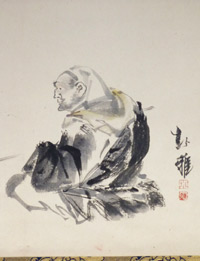
Click here to view image full size.
Utagawa HIROSHIGE (1797-1858)
Click here to view image full size.
A small drawing taken from an album of an old pine tree. Sumi and light colour on paper. Image size, 23.25 x 11 inches; 59 x 28 cms. Mounted as a painting. Very good condition. Signed Hiroshige.
Status: Sold
Utagawa TOYOKUNI I (1769-1825)
Click here to view image full size.
An important painting: Nanadaime Danjuro sugata-e, “Portrait of Danjuro VII.” Painted at the end of the Bunka period ( c. 1815 ), it shows the young Danjuro after his succession. He wears the Danjuro mimasugoshi, Danjuro’s triple-plaid kimono pattern. His favourite tobacco pouch with the bat-shaped catch is hanging at his waist. He is looking at two butterflies. An allusion to the famous story of Zhuang Zhou who dreams of being a butterfly, only to wake and wonder if he is, in fact, not a butterfly dreaming of being Zhuang Zhou. The story symbolizing the evanescence of life. A similar painting of Nakamura Utaemon II dated 1812 is in the Museum of Fine Arts, Boston, acc. No. 11.7864. Full colour on silk. Image size 23.25 x 11 inches; 59 x 28 cms. Two repaired wormholes not affecting image, otherwise very good condition. Interesting old embroidered and hand-painted mount. Signed Utagawa Toyokuni ga with seals Ichiyosai and Toyokuni.
Status: Sold
Utagawa HIROSHIGE (1797-1858)
Click here to view image full size.
A fine and rare painting: Gunkaku zu, “A Flock of Cranes.” Hiroshige designed many fine kachoga during the 1830s through to the 1850s but there exist few paintings. This was a commissioned work from Hiroshige. The tancho ( “red crest” ) Japanese Crane, Grus japonensis, is the second rarest crane in the world, migrating to East Asia in the fall to spend the winter. There is also a resident flock in Hokkaido. Much loved by the Japanese, the crane was a symbol of luck, longevity and fidelity. Full colour on silk, image size 34.5 x 15.75 inches; 88 x 40 cms. In perfect condition with a futo-maki ( thick wooden roll to preserve the painting from damage ). New box. Signed Ojyu ( “commissioned” work ) Ichiryusai hitsu. ( A rare form of the signature used c. Tenpo 10 to 11 [ around 1839 – 40 ]. ) The Ichiryusai seal is also a rare form used around mid Tenpo period.
Status: Sold
Utagawa KUNISADA (1786-1864)
Click here to view image full size.
An uncut fan print with title: Furyu yami no kaori, “A Refined Date in the Dark.” Shows a beauty holding a pipe and contemplating a dusky garden and her hidden lover. From a set published by Kojimaya Jubei, with date seal 3/1852.
Fine impression and colour. Small paper fibre on woman’s cheek, otherwise fine condition. Signed Konomi ni ujite ( “With my taste” ) Toyokuni ga.
Status: Sold
Katsushika HOKUSAI (1760-1849)
Click here to view image full size.
A poem by the Lady of Ise which speaks of a love that has not been reciprocated. From Hyakunin isshu uba ga etoki, the “Hundred Poems Explained by the Wet Nurse.” Published by Eijudo and Iseri, c.1835-6. Although obviously intended to be a set of 100 prints, only 27 are known plus drawings for others. The scene shows two ladies looking out over the rice fields to the Naniwa Inlet ( the ancient name for the region around Osaka ). The house is either being built or repaired with new tiles to the roof.
Exceptionally early impression with beautiful printing. This appears to be the earliest state with gradation on the roof bottom right and down from the top. Fine colour. Full size. Very slight centre fold, otherwise very good condition. Signed Zen Hokusai manji.
Status: Sold


